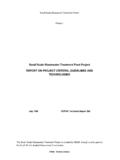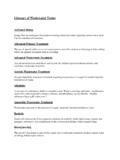Transcription of THE DOMESTIC WASTEWATER MANAGEMENT IN …
1 SEMINAR INCHEM TOKYO 2017. THE DOMESTIC WASTEWATER . MANAGEMENT IN indonesia . Current Situation And Future Development Tokyo, November 21, 2017. Ir. NUSA IDAMAN SAID, Senior Researcher Center of Technology for the Environment Agency for the Assessment and Application of Technology (BPPT). 1. INTRODUCTION. 2. CURRENT SITUATION. 3. FUTURE DEVELOPMENTS. 4. CONCLUSIONS. 2. Indonesian Population Based on data from the Minister of Home Affairs Republic of indonesia , the number of Indonesian population is 257,912,349 people. The growth rate of indonesia 's population is around percent. (Based on data of June 30, 2016). indonesia consists of 34 provinces. Currently, there are 416 districts in indonesia . The number of cities in indonesia is 98 cities. The total districts and cities in indonesia are 514 districts and cities. 3. Indonesian Population Sumatera Jawa Bali + Nusa Kalimantan Sulawesi Maluku +.
2 Tenggara Papua Percentage of Area Percentage of indonesia Population by Island Source: BPS, 2015 Percentage of Population 4. Environmental Issues in indonesia Water Pollution Highly Polluted River River Water Quality Monitoring In 2013. (411 Sampling Points). Source: Ministry of the Environment and Forestry, 2015. Heavy polluted Moderate polluted Slightly Polluted Meet the Standard DOMESTIC (Household). Livestock Agriculture Industry Pollution Sources in 5 River basin Hotel (Musi, Citarum, Ciliwung, Brantas, Hospital Barito) Solid waste Small scale industry 5. Source: Ministry of the Environment and Forestry, 2015. WASTEWATER POTENTIAL IN DKI JAKARTA. Total waste water discharged : Year 1989 : m3/day Year 2010 : m3/day 78,9. 80 72,7. Year 1989. 70. Percentage (%). Year 2010. 60. 50. 40. 30. 20 13,1 17,3. 9,9. 8,0. 10. 0. DOMESTIC Commercial Industry WASTEWATER Source Source: Japan International Cooperation Agency (JICA) Study, 1989.
3 Due to the low service of WASTEWATER treatment, especially DOMESTIC waste water, has caused severe river water pollution, especially in Java. 6. BOD Concentration Of Ciliwung River 2014. BOD Concentration of Ciliwung , 2014. mg/liter Kelapa Dua Intake PAM Kampung Jemb. Sebelum Jl. Halimun Jl. KH. Mas Jl. Gudang Jemb. Jl. Kwitang Jl. Gajah Jl. Ancol Jl. Raya Pompa Pluit / Srengseng Condet / Melayu Kalibata Pintu Air Mansyur / PLN / Pantai Mada Marina Pluit /. Sawah Kampung Dalam Manggarai Karet Kebon Indah Tangki Penjaringan Gedong Tengsin Melati Kapuk /. Muara Angke Feb Mei Jun Sep Okt BOD Concentration Of Citarum River 2014. BOD Concentration Of Citarum River 2014. mg/liter Wangisagara Koyod Setelah IPAL Cisirung Nanjung Outlet Waduk Bendung Walahar Tunggak Jati Jatiluhur April Mei Juli Sep Okt National Policy On The MANAGEMENT Of DOMESTIC WASTEWATER In indonesia Individual Treatment Community Based On-site sanitation Septage MANAGEMENT Intermediate solution Sanimas Community Sewerage System Institutional Based DOMESTIC Decentralized Permanent solution: WASTEWATER System Communal WWTP.
4 Expansion of existing centralized system Centralized system/City wide new cities 9. Individual, Community and Institutional-based Sanitation Approaches Source : indonesia Sanitation Report, 2014. 10. DOMESTIC WASTEWATER MANAGEMENT IN indonesia . STORAGE & FINAL. TRANSPORTATION. Processing PROCESSING. Sistem Setempat (On-Site). Sludge Treatment Plant individual/Communal SEPTIC SLUDGE. Truck Centralized MANHOLE. Sistem SR Settlement Sludge Terpusat (Off-Site) Treatment SR JARINGAN PERPIPAAN AIR LIMBAH. regional scale 11. 12. For urban areas with high population densities implemented with a centralized system. At present the centralized WASTEWATER MANAGEMENT system is located in only 12 cities with low service coverage (Totally below 5 %). To reduce quantities of worse sanitation in urban area, indonesia government introduced the community-based sanitation (SANIMAS).
5 Program to improve urban-poor sanitation since 2001. The pilot project of SANIMAS (community-based sanitation) program was initiated by AusAID. through WSP-EAP World Bank (Water and Sanitation Program East Asia Pacific) and was supported by the government of indonesia . Until now, SANIMAS has been implemented in all (27) provinces, and more than 300 locations. 13. Centralized WASTEWATER Treatment Plant Of 12 cities in indonesia WASTEWATER City System Total Capacity (m3/day). Treatment Plant Pulo Brayan Medan UASB (Up ow Anaerobic 10,000. Sludge Blanket) + Aerated Lagoon Ajibata Prapat Aerated Lagoon 2,000. Setiabudi DKI Jakarta Aerated Lagoon 60,480. Bojongsoang Bandung Anaerobic, Facultative & Maturation Pond 243,000. Kesenden Cirebon Anaerobic, Facultative & Maturation Pond 7,033. Ade Irma Cirebon Anaerobic, Facultative & Maturation Pond 5,626. Gelatik Cirebon Anaerobic, Facultative & Maturation Pond 3,944.
6 Rinjani Cirebon Anaerobic, Facultative & Maturation Pond 3,944. Sewon Yogyakarta Aerated Lagoon 15,500. Pucang Sawit Surakarta Aerob Facultative & Biofilter 9,504. Suwung Bali Aerated Lagoon 51,000. Margasari Balikpapan Extended Aeratin 800. HKSN Banjarmasin RBC 5,000. Pekapuran Raya Banjar Masin RBC 2500. Lambung Mangkurat Banjarmasin RBC 1,000. Basirih Banjarmasin RBC 2,000. Tata Banua Banjarmasin RBC 2,000. Sungai Andai Banjarmasin RBC 3,000. Sultan Adam Banjarmasin RBC 2,000. Margasari Balikpapan Extended Aeration 800. Sukasari Tangerang Oxidation Ditch 2,700. Batam Center Batam Oxidation Ditch 2,852. Boulevard Manado 2,000. 14. Source : indonesia Sanitation Report, 2014. and Ministry of Public Work. Pulo Brayan WASTEWATER Plant - Medan The plant using a combination of UASB process and aerated lagoon. After two screens, a coarse one and a fine one, the WASTEWATER flows through a grit chamber.
7 The fine screen and the grit chamber are equipped with automatic cleaners. In an Upflow Anaerobic Sludge Blanket (UASB) reactor the WASTEWATER is treated anaerobically. The UASB has no return system and also no pH adjustment system as usually designed. After the UASB the WASTEWATER flows into a facultative lagoon. The lagoon is equipped with two aerators. The aerators are operated for only 4-5 hours each day to reduce energy cost. The effluent is discharged into river Kera. The effluent COD is in the range of 50 to 75mg/l and the BOD between 40 and 55mg/l. The process diagram of the Pulo Brayan WWTP. 15. PULO BRAYAN MEDAN WASTEWATER TREATMENT PLANT. AERATED LAGOON. UASB REACTOR. SCREW PUMPS. EFFLUENT. BOD 40 55 mg/L. 16. GRIT CHAMBER. Suwung WWTP - Denpasar Effluent SUWUNG WASTE WATER PLANT CAPACITY 51,000 M3/DAY 17. BANJARMASIN WWTP USING RBC SYSTEM.
8 18. WWTP Margasari Balikpapan (Extended Aeration With Surface Aerator). Capacity : 2000 m3/day 19. Examples : On-site Sanitation: Small Scale Community Sewerage System (SANIMAS). A total of approximately 1700 decentralized WASTEWATER treatment systems (DEWATS) have been constructed until 2015. This year, Sanimas will be built in 753 locations spread across various provinces in indonesia . 20. Combined System Public Toilets And Simple Piping Equipped With Biodigester 21. Small Scale Community Sewerage System Using Anaerobic Baffle Reactor pt o pr a Su dn Outlet Jembatan Se rang an ej te . L Jln. KHA Dahlan nl J. yi m as H. id cha W. 220 B 1. KH. C A ln. 2 J. D. 3. Inlet go inon 4. W. i al K 7. 8. 6 9 RT 01. 13. 12. 11. 5. RT 02. 1 10 29. 30 28. RT 05 19 27 2. 20. 21. 2 22. 23 24 26. 3 1 6 7 9 17 18. 18. 17 25. 1 5 8. 10 11 10 16 15. 4. 5 19. 21 11 13 14.
9 16 2 4. 8. 2 12. 6 11 14 RT 04 18 1 3. 15 RT 03. 7. A TS. 3. EW. D 12. 9 4. EM. T U 9. n KETERANGAN. SS. I 5 ga 8 13 16. L 17 26 25 an A LOKASI IPAL DEWATS 24 23 x Rumah Penduduk IP er S. 6 7 Batas RT. 14 15. 20 21. SD. 0 5 10 15 20m 22 k Pipa Utama 10 bo em Lokasi IPAL. T. Bak Kontrol 22. Small Scale Community Sewerage System Using Anaerobic Biofilter Typical Anaerobic Biofilter Communal WWTP (Sanimas) Ds. Ploso, Jombang City Communal WWTP (Sanimas) Ds. Communal WWTP (Sanimas) Ds. 23. Tunggorono, Jombang City Tlekung, Batu City Business units such as hotels, office buildings, shopping centers, hospitals, industries and their businesses which have not been served by the sewerage network have to treat their own DOMESTIC WASTEWATER . WASTEWATER treatment technology that is widely used by business activities: 1. Activated Sludge Process 2. Biofilter Process: Both Anaerobic-Aerobic Biofilter and Aerobic Bioflter.
10 3. Rotating Biological Reactor (RBC). 4. Now, have started to use Membrane Bio Reactor (MBR) technology for DOMESTIC WASTEWATER treatment. 24. APPLICATION OF ACTIVATED SLUDGE TECHNOLOGY FOR DOMESTIC . WASTEWATER TREATMENT IN indonesia . Activated sludge process is widely used because its construction is relatively simple, but its operation requires operators with relatively high skill. The failure of the activated sludge process in Jakarta is largely due to poor operation. Active sludge process is widely used especially in high rise buildings and in 25. industry. WASTEWATER TERATMENT USING OXYDATION DITCH PROCESS. LOCATION : JABABEKA CAPACITY 18,000 M3 PER DAY. OXYDATION DITCH. PRIMARY FINAL. SEDIMENTATION TANK SEDEMENTATION. TANK. TREATED. WATER. RECYCLE SLUDGE. 26. APPLICATION OF ANAEROBIC-AEROBIC BIOFILTER TECHNOLOGY. FOR DOMESTIC WASTE WATER TREATMENT IN indonesia .









